Bryan L. Programmable controllers. Theory and implementation
Подождите немного. Документ загружается.

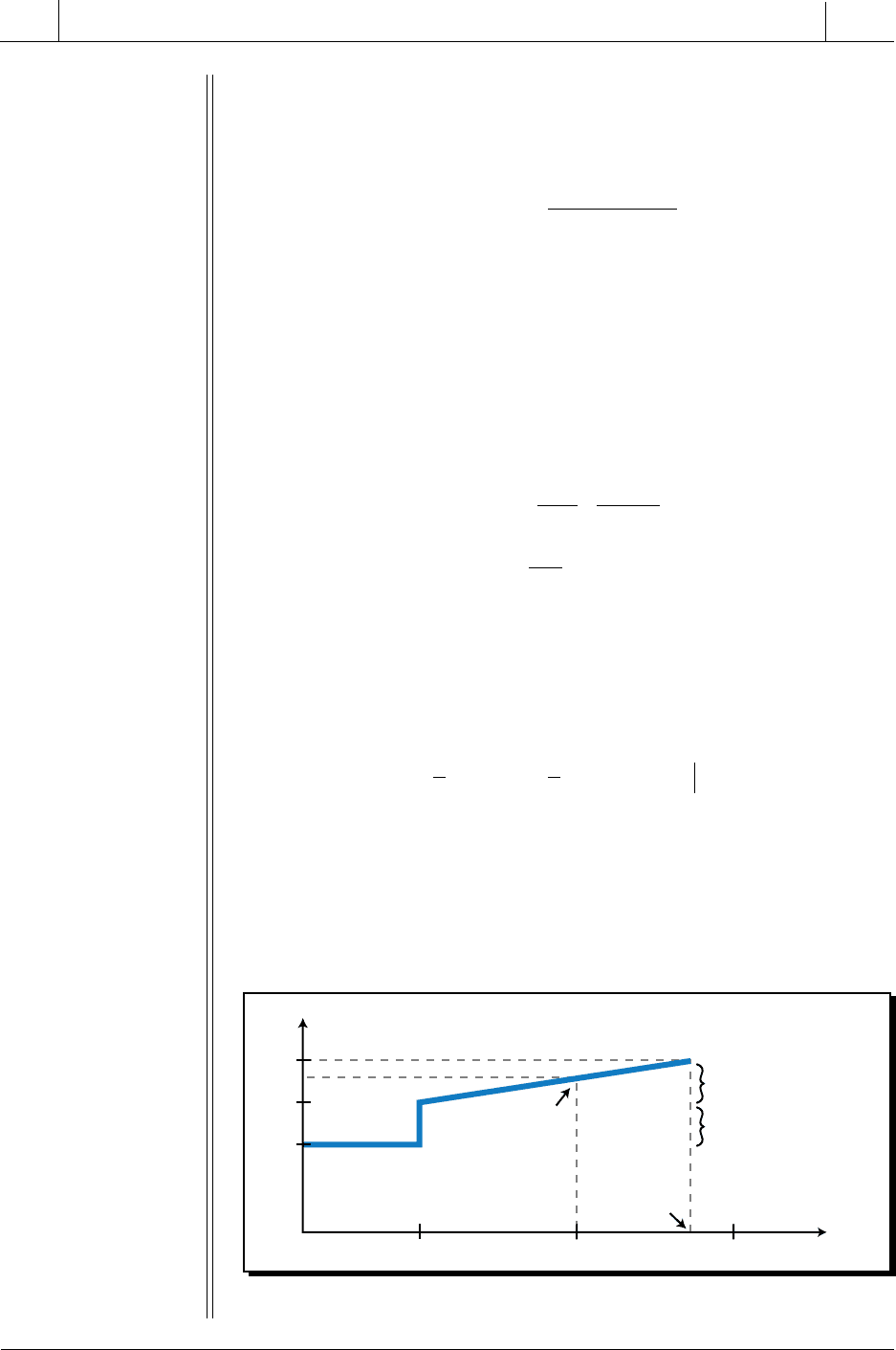
719
CHAPTER
15
Process Controllers
and Loop Tuning
SECTION
4
PLC Process
Applications
Industrial Text & Video Company 1-800-752-8398
www.industrialtext.com
SOLUTION
(a) The error created in the system over the
PV
range is:
E
(%)
%
=
°− °
°− °
=
155 150
200 100
5
FF
FF
The given values of the proportional and integral actions are:
K
K
P
I
=
=
−
2
001
1
%/%
. sec
Thus, the value
K
I
in minutes is:
K
I
=
=
=
−
001 60
1
06
06
1
.
sec
sec
min
.
min
. min
The control variable for this series PI controller is defined as:
CV K E K K Edt CV
new P P I
t
t
t
t
=+ +
=
(
)
(
)
[]
+
(
)
(
)
+
=+
(
)
(
)
(
)
[]
+
=++
=
∫
=
−
=
=
−
0
0
1
0
1
1
25 206 5 50
10 10 0 6 1 0 50
10 6 50
66
()
%
%
%
%
% . min % %
% % . min min min %
%% %
%
–
Figure 15-48 illustrates this control variable response.
Figure 15-48. Control variable response.
t
= 0
t
= 1
t
= 2
CV
t
(min)
50%
60%
70%
66%
Integral
Proportional
Proportional
Gain
Integral
Gain
=
1.667 min

720
SECTION
4
PLC Process
Applications
Industrial Text & Video Company 1-800-752-8398
www.industrialtext.com
CHAPTER
15
Process Controllers
and Loop Tuning
(b) The integral gain will equal the proportional gain in 1.667 minutes:
KE KKEt
t
t
PPI
=
=
(
)
=
(
)
=
−
−
( %)( %) ( %) . min ( %)()
.
. min
25 206 5
1
06
1 667
1
1
min
Figure 15-49. (a) A series PI controller (
Hc
) controlling a second-order process and
(b) the normalized response of the process variable to a change in set
point for various values of
T
I
. The proportional gain
K
P
is equal to 2%/%
for all values of
T
I
.
HpHc
EPVSP
+
–
Σ
K
P
+
K
I
s
1
(10
s
+ 1)(2.5
s
+ 1)
1
T
I
=
2
s
+
s
PV
Second-Order Process
(
τ
1
= 10 min,
τ
2
= 2.5 min)
1.5
1.0
0.5
0
10 20 30
PV
t
(min)
Integral Time
T
I
= 2 min
5
10
20
50
T
I
= ∞
(a)
(b)
The integral, or reset, time of a PI controller influences the ultimate closed-
loop response of the system (see Figure 15-49). As the reset time decreases,
the response speed increases, creating an overshoot. The overshoot in the
response will cause the proportional action to initiate a negative increase
(reduction of output), producing an oscillating response.
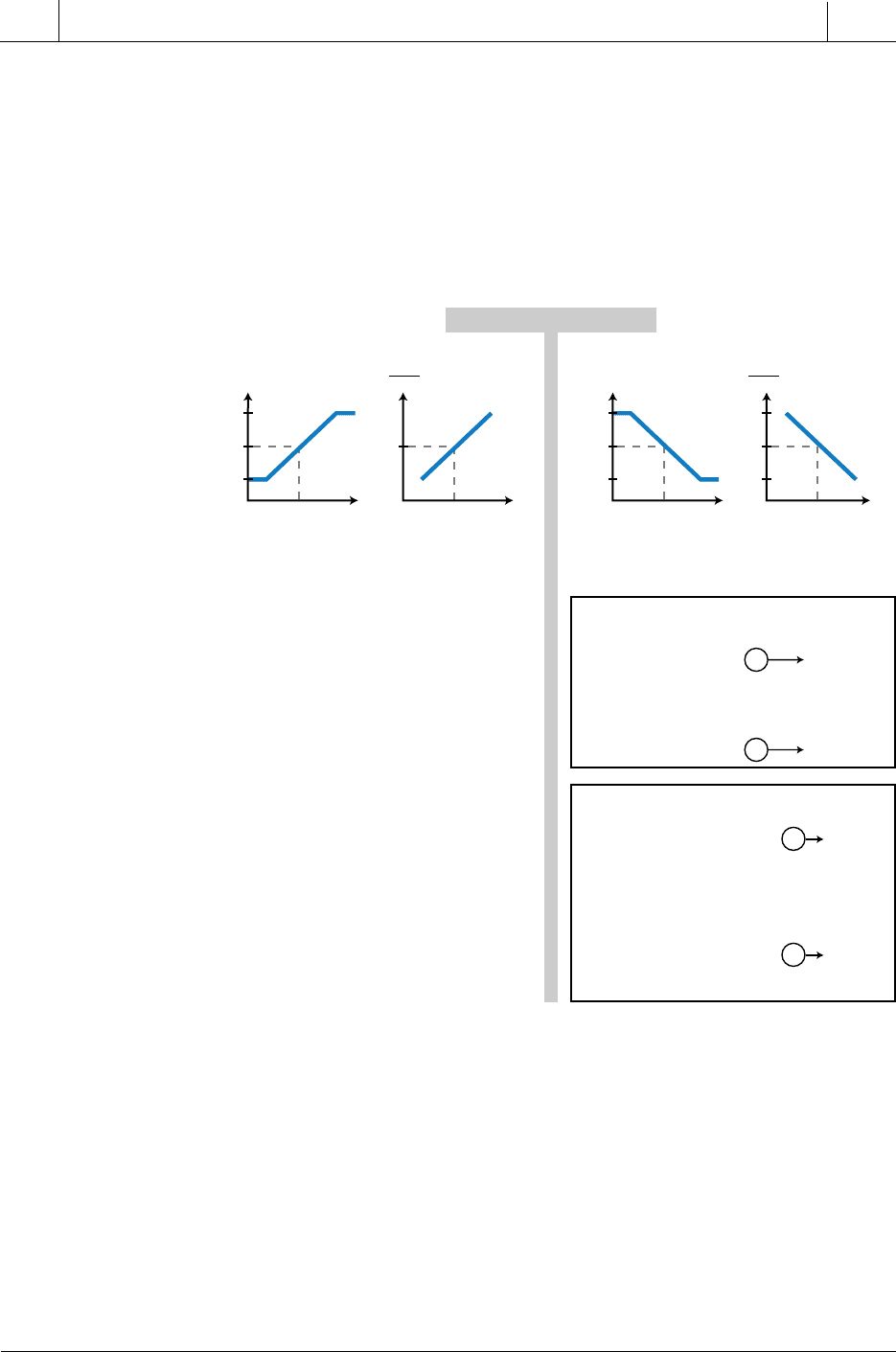
721
CHAPTER
15
Process Controllers
and Loop Tuning
SECTION
4
PLC Process
Applications
Industrial Text & Video Company 1-800-752-8398
www.industrialtext.com
The signs of the proportional gain (K
P
E) and the combined proportional-
integral gain (
K K Edt
PI
∫
) terms are important when determining the integral
gain curves for reverse-acting and direct-acting series PI controllers. In the
direct-acting mode (see Figure 15-50a), the signs of K
P
and K
I
are both
positive. Therefore, a negative error will make both the K
P
and K
I
terms
negative, resulting in proper controller action. Similarly, a positive error will
make both terms positive, again resulting in proper direct action control.
Figure 15-50. Gain curves for (a) direct- and (b) reverse-acting series PI controllers.
In a reverse-acting series PI controller, both the proportional gain and the
combined proportional-integral gain (K
P
K
I
) must be negative (–K
P
K
I
) for the
controller to correctly implement a reverse action (see Figure 15-50b). This
means that the integral gain must be positive—a negative integral gain
would result in a positive combined gain term. Since the proportional gain
must be negative, the output of a reverse-acting series PI controller can be
expressed as:
100%
50%
0%
CV
dCV
dt
CV
E
= –
E
= 0
E
= +
E
%
+
0
–
+
0
–
E
= –
E
= 0
E
= +
E
%
E
= –
E
= 0
E
= +
E
%
E
= –
E
= 0
E
= +
E
%
100%
50%
0%
Direct-Acting Reverse-Acting
Series PI Controller
CV
=
K
P
E
+
K
P
K
I
∫
Edt
+
CV
(0)
(+
K
P
)(+
E
)
(+
K
P
)(+
K
I
)(+
E
)
++
(+
K
P
)(–
E
)
(+
K
P
)(+
K
I
)(–
E
)
––
CV
increases
CV
decreases
(–
K
P
)(+
E
)
(–
K
P
)(–
K
I
)(+
E
)
(–
K
P
)(+E)
(–
K
P
)(–
K
I
)(+
E
)
(–
K
P
)[(+
E
)+(+
K
I
)(+
E
)]
–
––
+
(–
K
P
)(–
E
)
(–
K
P
)(–
K
I
)(–
E
)
+–
Incorrect
Incorrect
Correct
Correct
If % error is + :
If % error is – :
If % error is +:
If % error is +:
If % error is –:
OR
(–
K
P
)(–E)
(–
K
P
)(–
K
I
)(–
E
)
(–
K
P
)[(–
E
)+(+
K
I
)(–
E
)]
+–
If % error is –:
OR
0
t
CV
=
K
P
E
+
K
P
K
I
∫
Edt
+
CV
(0)
0
t
dCV
dt
(b)(a)
CV decreases
CV increases

722
SECTION
4
PLC Process
Applications
Industrial Text & Video Company 1-800-752-8398
www.industrialtext.com
CHAPTER
15
Process Controllers
and Loop Tuning
CV K E K Edt CV
PI
t
tnew
=− +
()
+
∫
=
0
0()
The negative sign in the proportional gain term ensures that the controller
will operate as reverse-acting. In a PLC system, the user enters the values for
K
P
and K
I
; therefore, some manufacturers of series PI controllers allow the
user to select a reverse-acting controller by specifying the proportional gain
as a negative value. In this type of system, the controller takes care of all
other computational signs, to ensure proper controller action and a proper
control variable response. Otherwise, when the error is positive, one term
(proportional) reduces the value of CV, while the other (integral) adds to it and
vice versa if the error is negative.
The following example illustrates how a PI controller ultimately brings the
error in a closed-loop system to zero at steady state. This example is an
extension of Example 15-5, which used only proportional control and, as a
result, had an offset error.
EXAMPLE 15-8
The closed-loop system in Example 15-5 has a first-order process
with a gain of 5 and a time constant of
τ = 30 seconds. The controller
has a proportional gain of
K
P
= 8. If the controller also has an integral
action with a gain of
K
I
= 0.1 sec
–1
, forming a PI parallel controller, find
(a) the closed-loop transfer function of the system and (b) the
steady-state value of the response to a unit step change in set point.
S
OLUTION
(a) The process’s transfer function is defined by:
Hp
s
s
()
=
+
5
30 1
The controller’s transfer function is expressed as:
Hc K E K Edt
Hc K
K
s
Ks K
s
s
s
tP I
t
sP
I
PI
()
()
.
=+
=+
=
+
=
+
∫
0
801

723
CHAPTER
15
Process Controllers
and Loop Tuning
SECTION
4
PLC Process
Applications
Industrial Text & Video Company 1-800-752-8398
www.industrialtext.com
Therefore, the closed-loop transfer function is:
PV
SP
Hc Hp
Hc Hp
s
ss
s
s
ss
ss
s
ss
s
ss
s
ss
sss
ss
()
()
() ()
() ()
.
.
.
.
.
.
=
+
=
(
)
(
)
[]
(
)
(
)
+
[]
=
(
)
(
)
=
+
++
+
+
+
+
+
+
++ +
+
1
1
40 0 5
30 41 0 5
801 5
30 1
801 5
30 1
40 0 5
30
40 0 5 30
30
2
2
2
2
(b) The response of the process variable to a step change in set point
is represented by:
PV SP
s
ss
s
s
ss
ss
() ()
.
.
.
.
=
+
++
=
+
++
40 0 5
30 41 0 5
14005
30 41 0 5
2
2
The final value of the process variable at steady state can be com-
puted by taking the inverse Laplace transform of
PV
(
s
)
to obtain
PV
(
t
)
and then evaluating the response value as
t
approaches infinity (
t
→
∞). However, obtaining the inverse Laplace transform of this response
can be very cumbersome. So, as an alternative, we can use the final
value theorem and apply it to the equation in the Laplace, or fre-
quency, domain:
lim ( ) lim
()
ts
s
ft sF
→∞ →
=
0
The steady-state value of the process variable in response to a unit
step input change can be found by multiplying the Laplace equation
times
s
and evaluating it as
s
approaches zero. Therefore:
lim
.
.
() .
() () .
.
.
()
s
s
sPV s
s
s
ss
→
=
(
)
+
++
=
+
++
=
=
0
2
2
14005
30 41 0 5
400 0 5
300 410 0 5
05
05
1
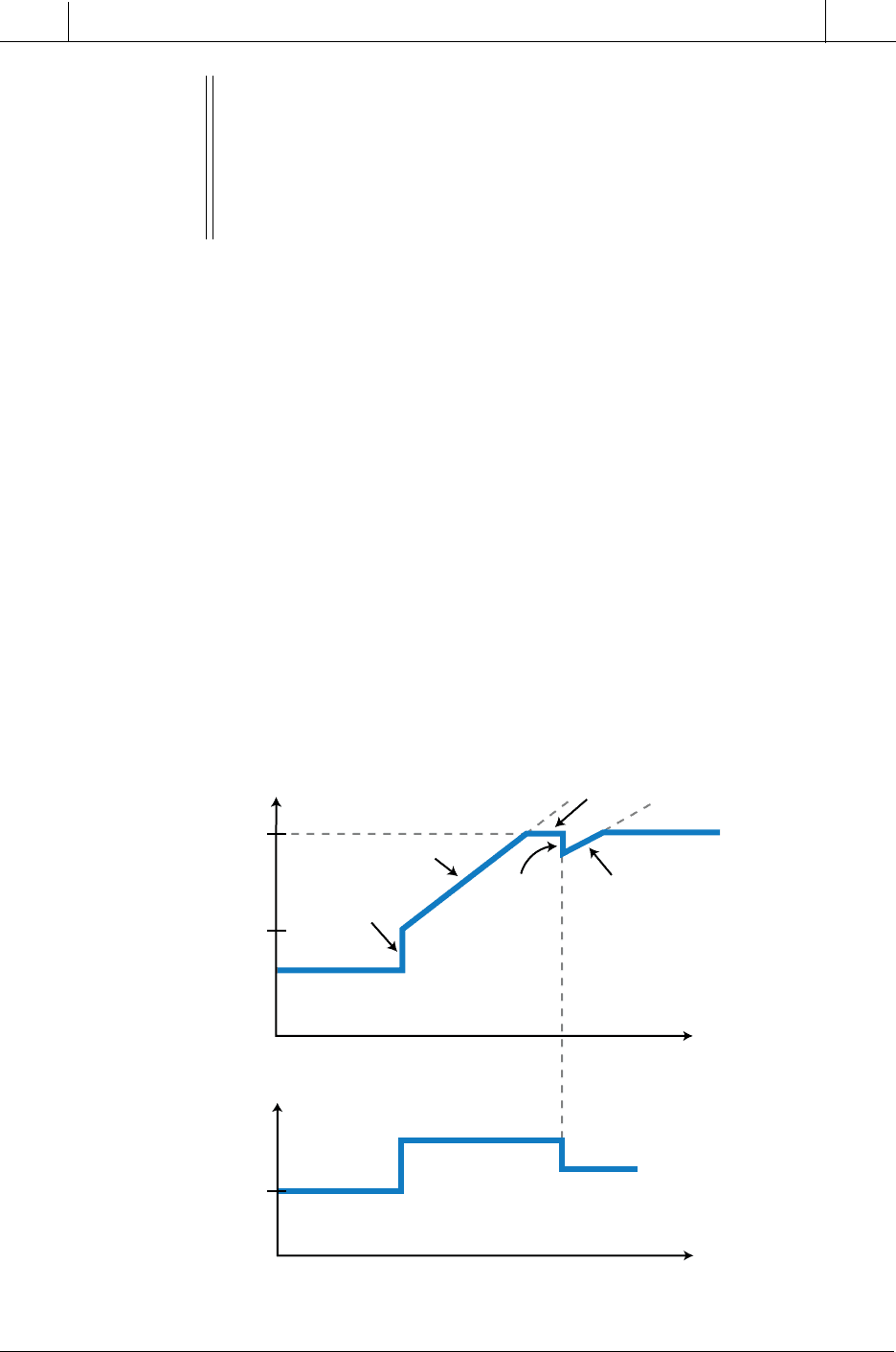
724
SECTION
4
PLC Process
Applications
Industrial Text & Video Company 1-800-752-8398
www.industrialtext.com
CHAPTER
15
Process Controllers
and Loop Tuning
Thus, the error will be zero at steady state:
ESPPV
=−
=−
=
11
0
Figure 15-51. Saturation of the control variable output.
A PI controller may create a situation in which it saturates the control
variable output. Saturation occurs when the control variable output remains
pegged at its maximum value (100%). The control variable will remain
saturated even if the error starts to come down (see Figure 15-51). The
integral action will not change direction until the percentage of error
becomes negative (PV > SP). This situation is called integral windup, or
reset windup, and it can be damaging to the process. It occurs when a large
error is present in a system with a slow response (large time constant). In
this situation, the controller will keep increasing the control variable value
because the error remains constant due to the lag’s effect on the integral
corrective action. Eventually, the control variable will saturate at 100%. In
other words, the controller’s corrective action continues to occur when the
process takes too long to respond. The start-up of a batch process is a typical
example of a situation in which a reset windup can occur. As we’ll discuss
later, this condition can be prevented.
E
= 0
Error %
t
t
Integral
Integral
Proportional
Proportional
Integral control continues while
proportional control also provides
output control proportional to the
positive error.
100%
50%
0%
Saturation
CV
+
–
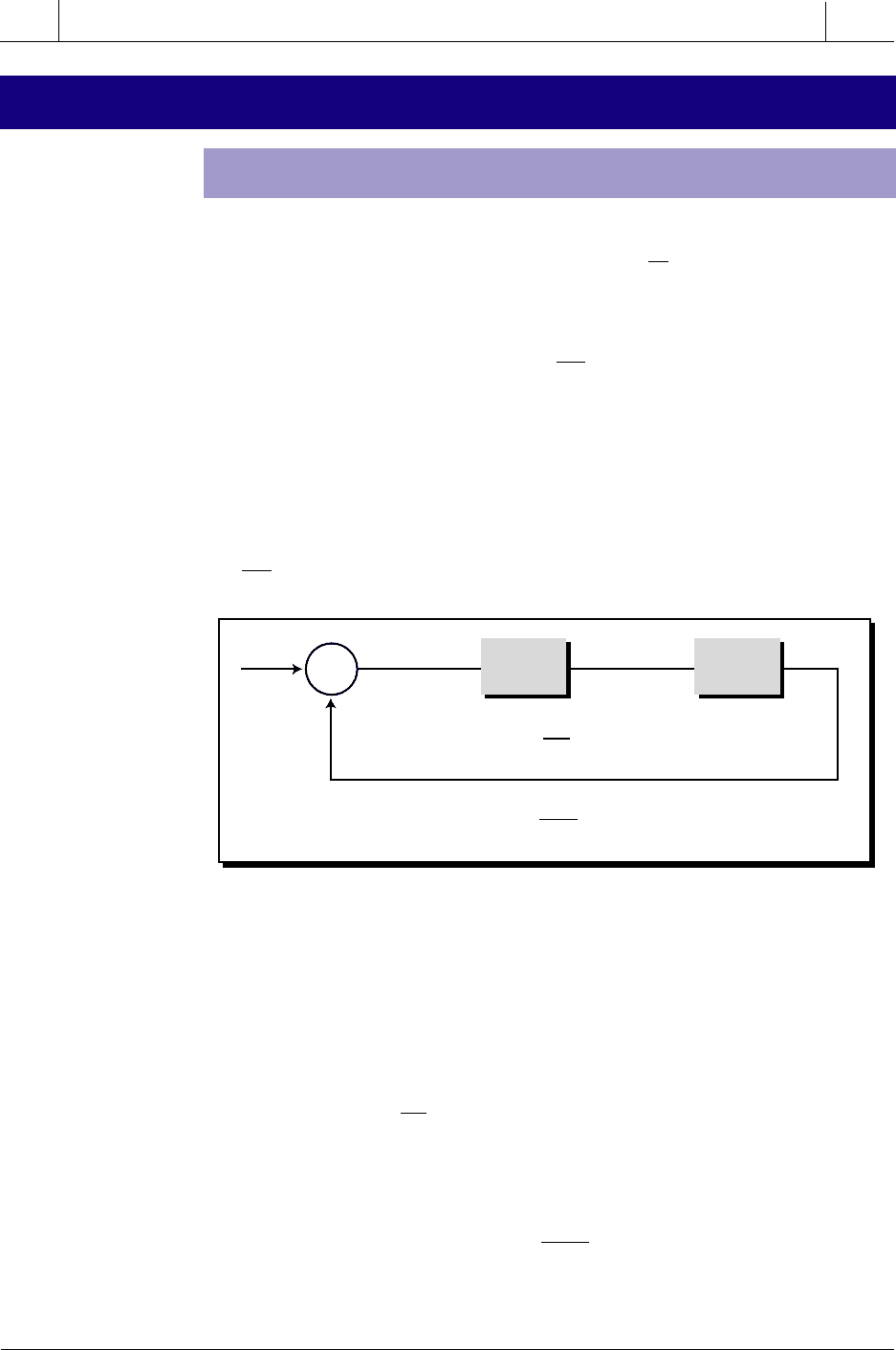
725
CHAPTER
15
Process Controllers
and Loop Tuning
SECTION
4
PLC Process
Applications
Industrial Text & Video Company 1-800-752-8398
www.industrialtext.com
15-8 DERIVATIVE CONTROLLERS (D MODE)
STANDARD DERIVATIVE CONTROLLERS
The output of a derivative controller is proportional to the rate of change
of the error in the system, which is expressed as
dE
dt
(see Figure 15-52). This
derivative action, also referred to as rate mode, is expressed mathematically
as:
CV K
dE
dt
CV
Dnew old
=+
where:
CV
CV CV
K
dE
dt
D
new
old
the control variable
the previous value of
the derivative gain constant in %(sec/%)
the rate of change of error over the duration of change in %/sec
=
=
=
=
Figure 15-52. Derivative controller action.
The derivative gain constant (K
D
) is also referred to as the rate time. It can be
expressed in seconds or minutes as:
KT
K
T
T
DD
D
D
D
=
=
seconds (rate time)
or
minutes (if is given in seconds)
60
In Laplace form, the derivative controller transfer function takes the form:
Hc
CV
E
Ks Ts
s
s
s
DD
()
()
()
=
==
HpHc
Hc
=
K
D
E = SP – PV PVSP
+
–
Σ
PV
dE
dt
Hc
(
s
)
==
K
D
s
CV
(
s
)
E
(
s
)
CV
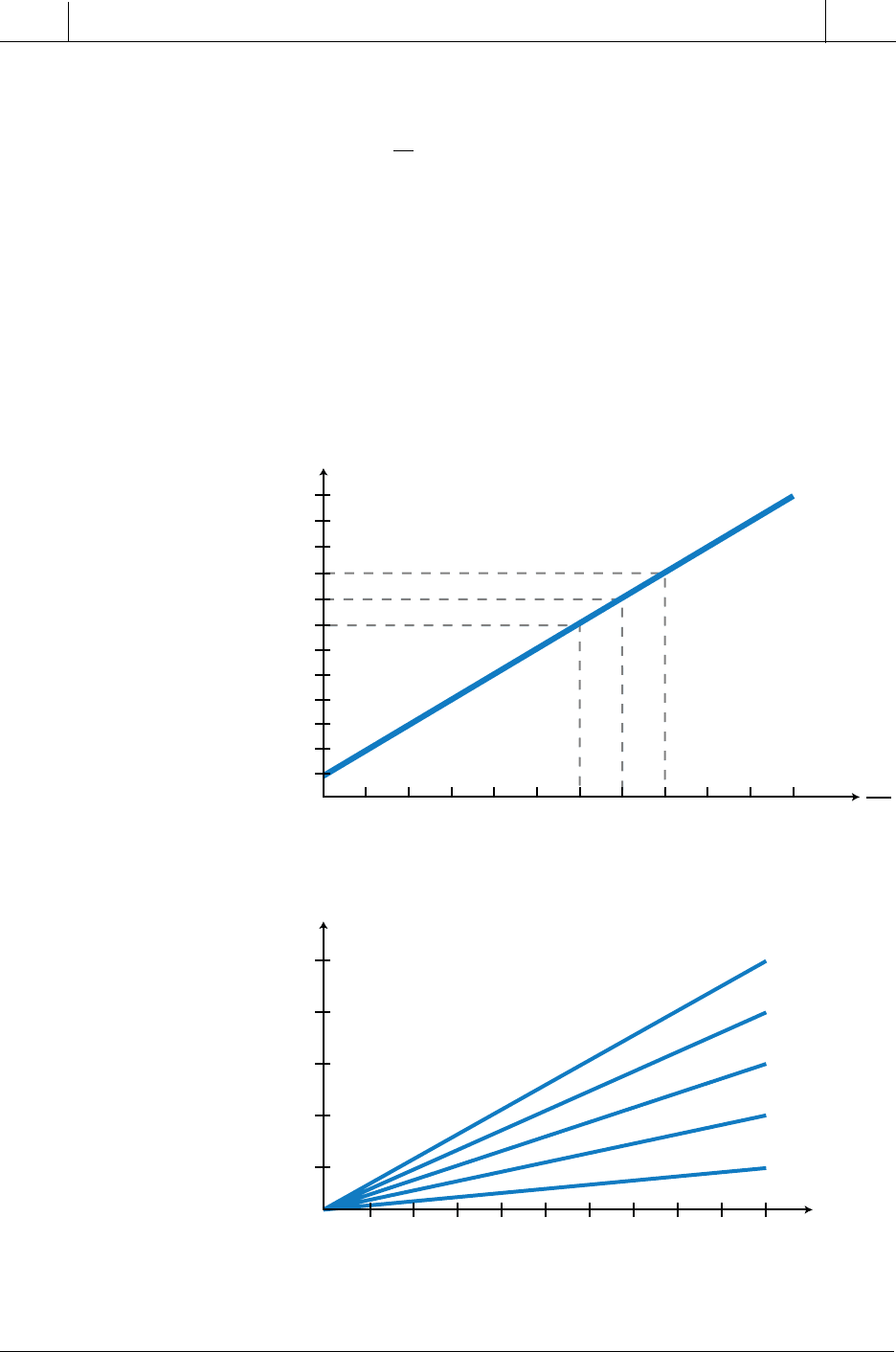
726
SECTION
4
PLC Process
Applications
Industrial Text & Video Company 1-800-752-8398
www.industrialtext.com
CHAPTER
15
Process Controllers
and Loop Tuning
Figure 15-53 illustrates the derivative gain transfer function in a direct-
acting system by indicating the corresponding controller outputs for differ-
ent rates of change (
dE
dt
) in error. Like in the integral mode, the rates of error
change form several family curves (see Figure 15-53b). For example, if the
error increases at a rate of 1.0%/sec, the controller will apply a derivative
action that makes its output jump from 50% to 70% (see Figure 15-53a).
If the rate of increase slows down to 0.5%/sec, the controller will decrease its
output to 60%. When the rate of change of error equals zero, the controller will
decrease its output to 50% again (see Figure 15-54). Note that the derivative
action is based on the rate at which the error changes, not the actual value of
the error.
Figure 15-53. (a) Derivative controller transfer function and (b) its family of curves.
100%
50%
0%
dE
dt
-2.5 -2.0 -1.5 -1.0 -0.5
0–+
+0.5 +1.0 +1.5 +2.0 +2.5
CV
(a)
70%
60%
25%
20%
15%
10%
5%
t
(sec)
Error %
12345678910
0.5%/sec rate
1.0%/sec rate
1.5%/sec rate
2.0%/sec rate
2.5%/sec rate
(b)
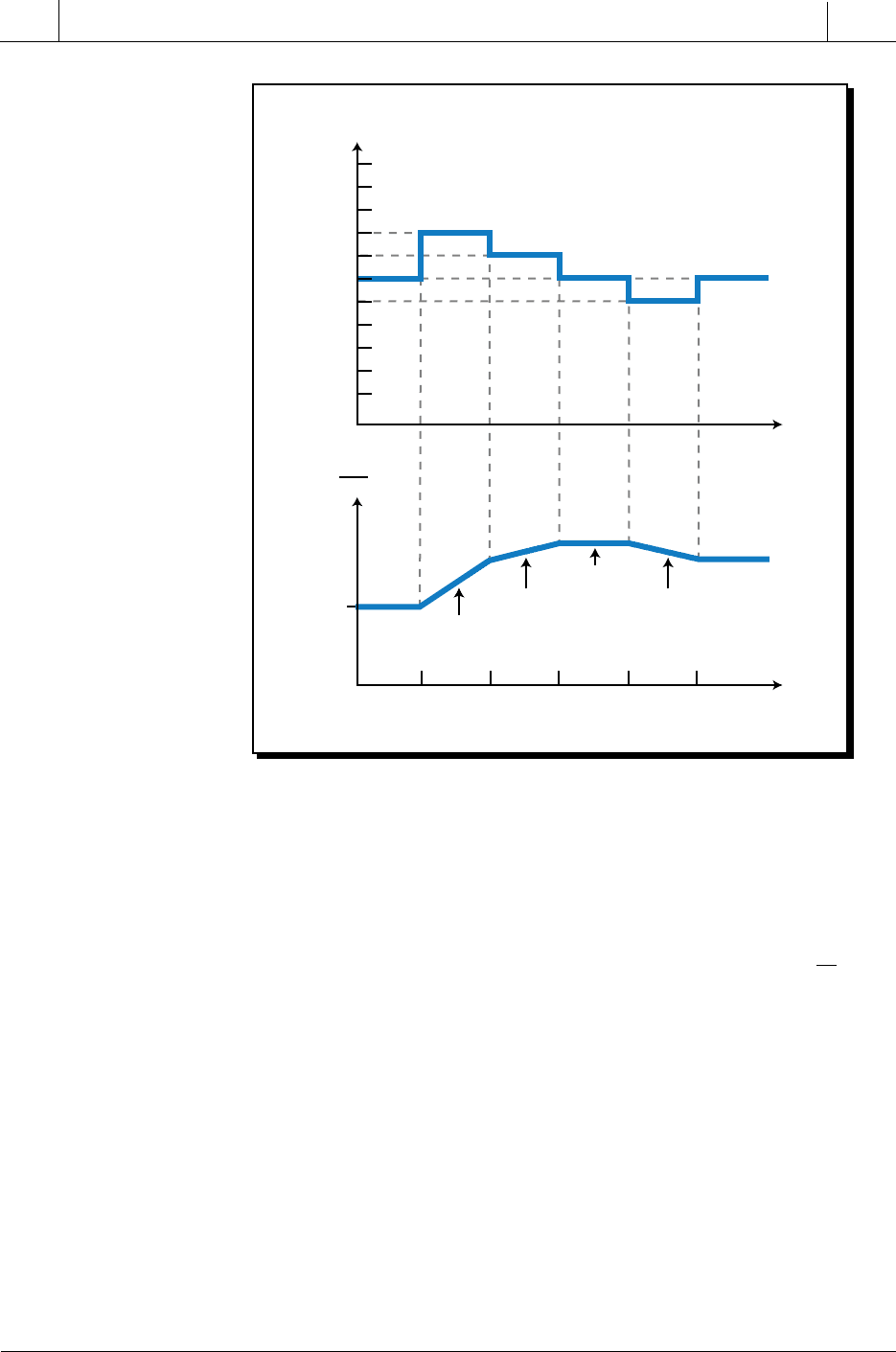
727
CHAPTER
15
Process Controllers
and Loop Tuning
SECTION
4
PLC Process
Applications
Industrial Text & Video Company 1-800-752-8398
www.industrialtext.com
Figure 15-54. Derivative controller response for the transfer function shown in
Figure 15-53a.
Derivative action is not used by itself in a controller; rather, it is used in
combination with proportional and proportional-integral actions. There are
several reasons for this. First, the derivative action response to a step change
(see Figure 15-55a) creates an infinite change in error over time (
dE
dt
=∞
),
causing the output of the controller to have 100% saturation for an instant
(point 1 in Figure 15-55b). If the error remains at its stepped up value, the
controller will sense no change and will return the control variable to 50%
(between points 1 and 2). At point 2, when the error drops in a step fashion
(see Figure 15-55a), the control variable will again have an infinite change
over time, thus causing a 0% output (point 2 in Figure 15-55b).
The second reason why derivative action is not used alone is that it only
produces a change in output if there is a change in the rate of error (points 3,
5, 6, and 7 in Figure 15-55). If a large error remains constant, the controller
will maintain the control variable at 50% of its range (point 8), thus the error
will not be corrected.
100%
70%
60%
50%
40%
0%
0
t
t
t
0
t
1
t
2
t
3
t
4
t
5
dE
dt
Rate: 1%
Rate: 0.5%
Rate: –0.5%
Rate: 0%
CV
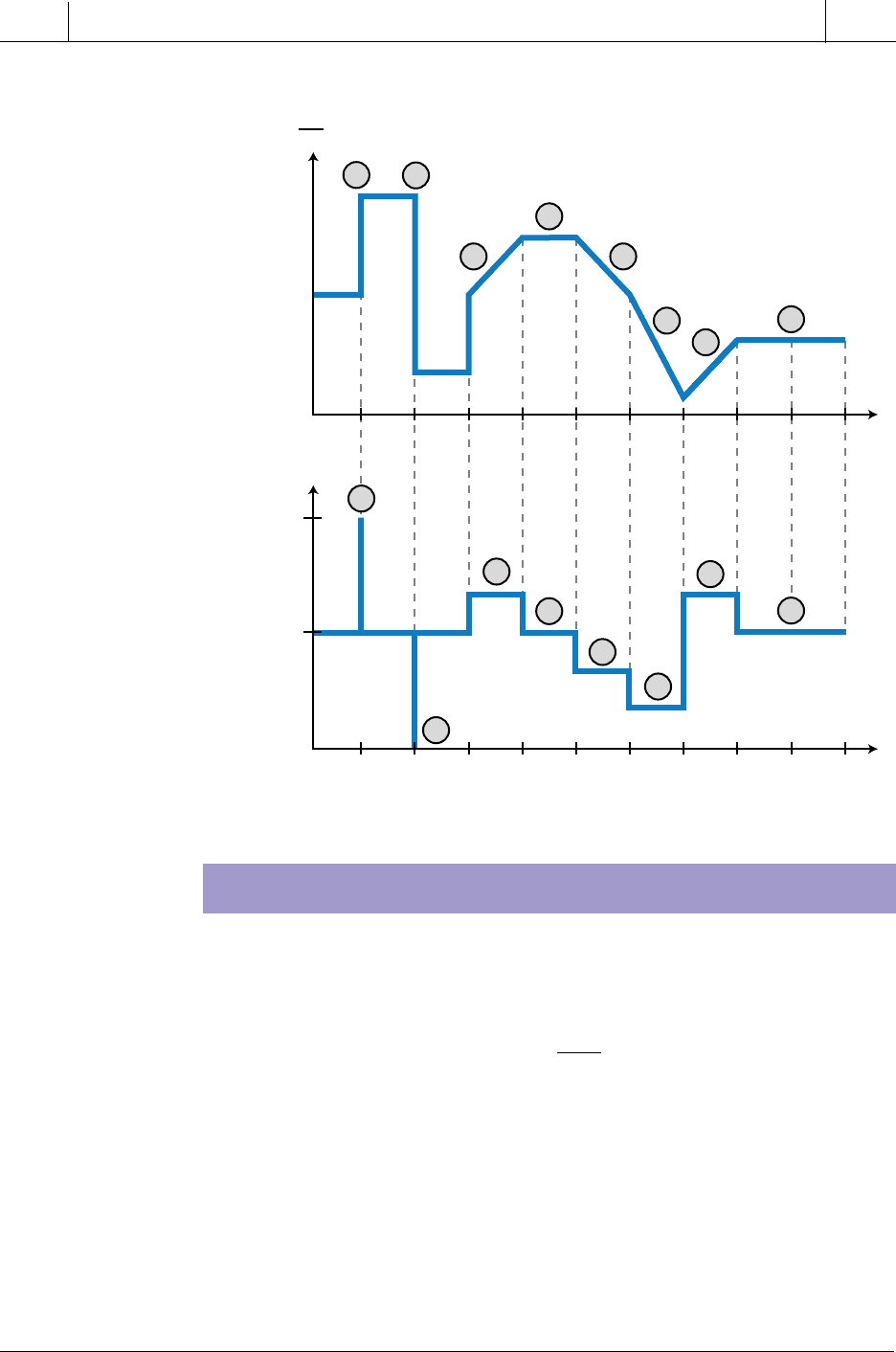
728
SECTION
4
PLC Process
Applications
Industrial Text & Video Company 1-800-752-8398
www.industrialtext.com
CHAPTER
15
Process Controllers
and Loop Tuning
MODIFIED DERIVATIVE CONTROLLERS
Derivative action may also be expressed in terms of the change in the
process variable rate over time:
CV K
dPV
dt
CV
Dnew old
=− +
This type of derivative action, used by some PLCs, avoids the saturation of
the control variable in response to a step change in the set point. In this type
of controller, the control variable tracks the process variable, which is very
unlikely to change in a step fashion.
Note that the sign of the K
D
term for a modified derivative controller is
negative. It is derived from:
Figure 15-55. (a) Step changes and (b) their corresponding derivative responses.
100%
50%
0%
+
0
–
dE
dt
CV
t
t
1
1
2
2
3
3
5
5
6
6
7
7
4
4
8
8
(a)
(b)
